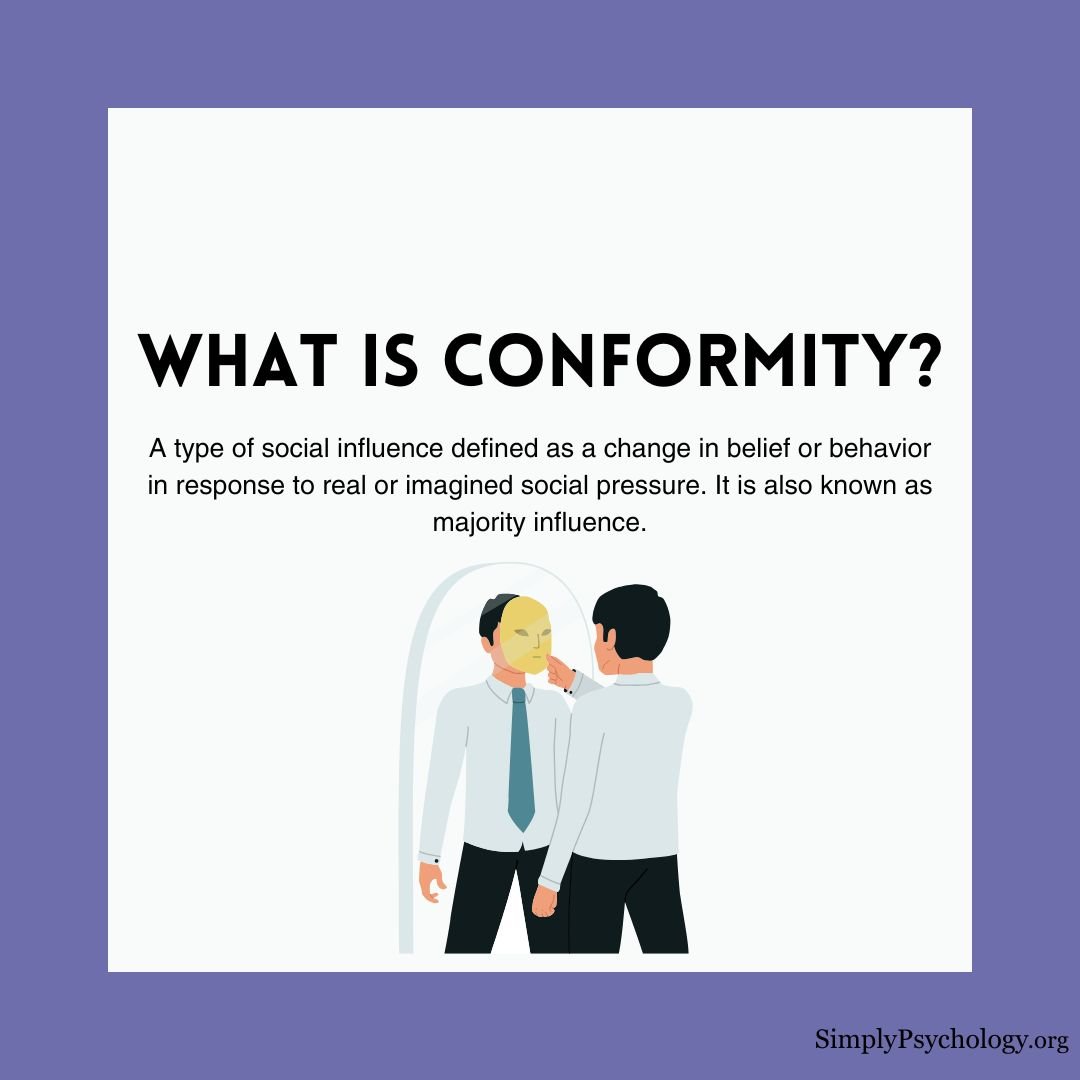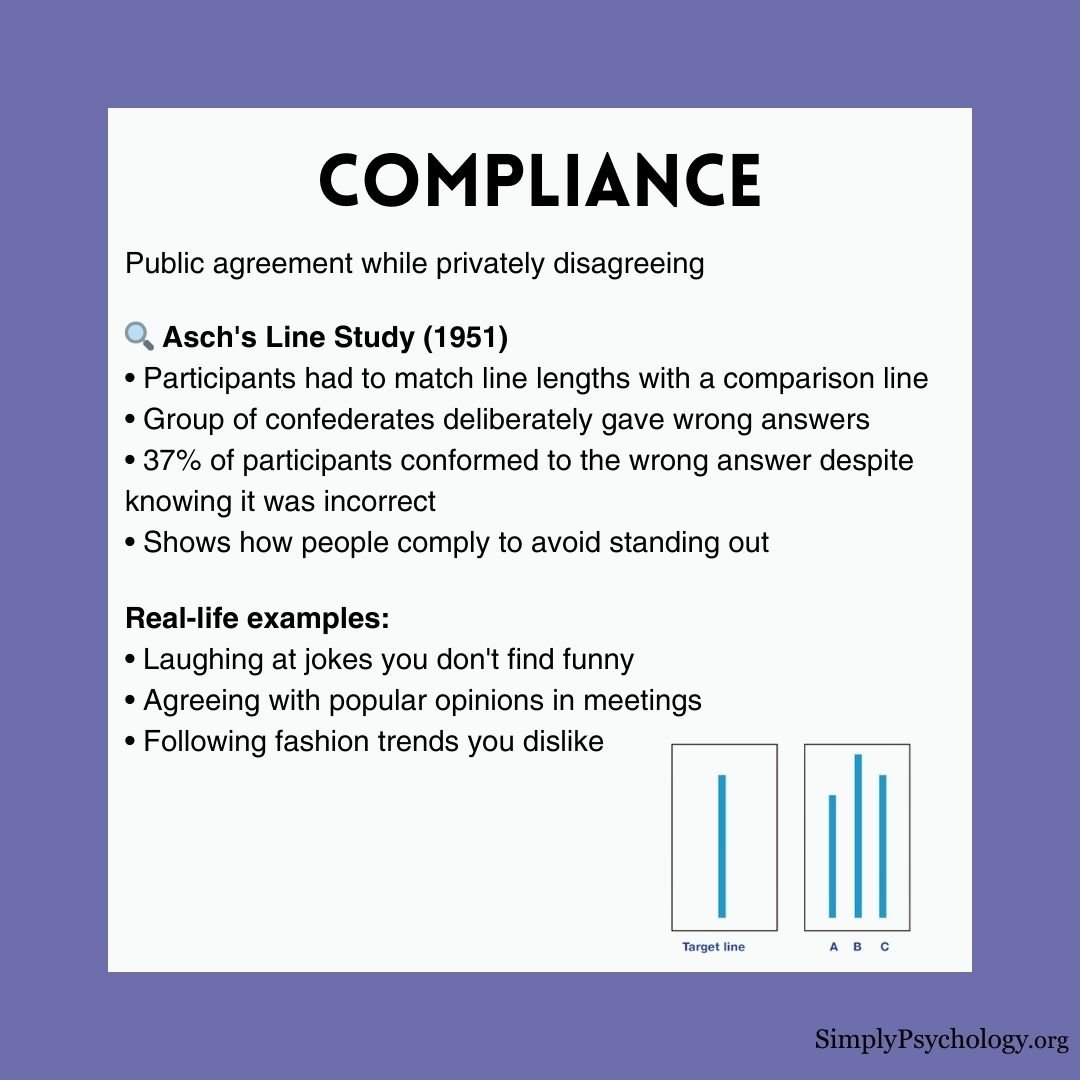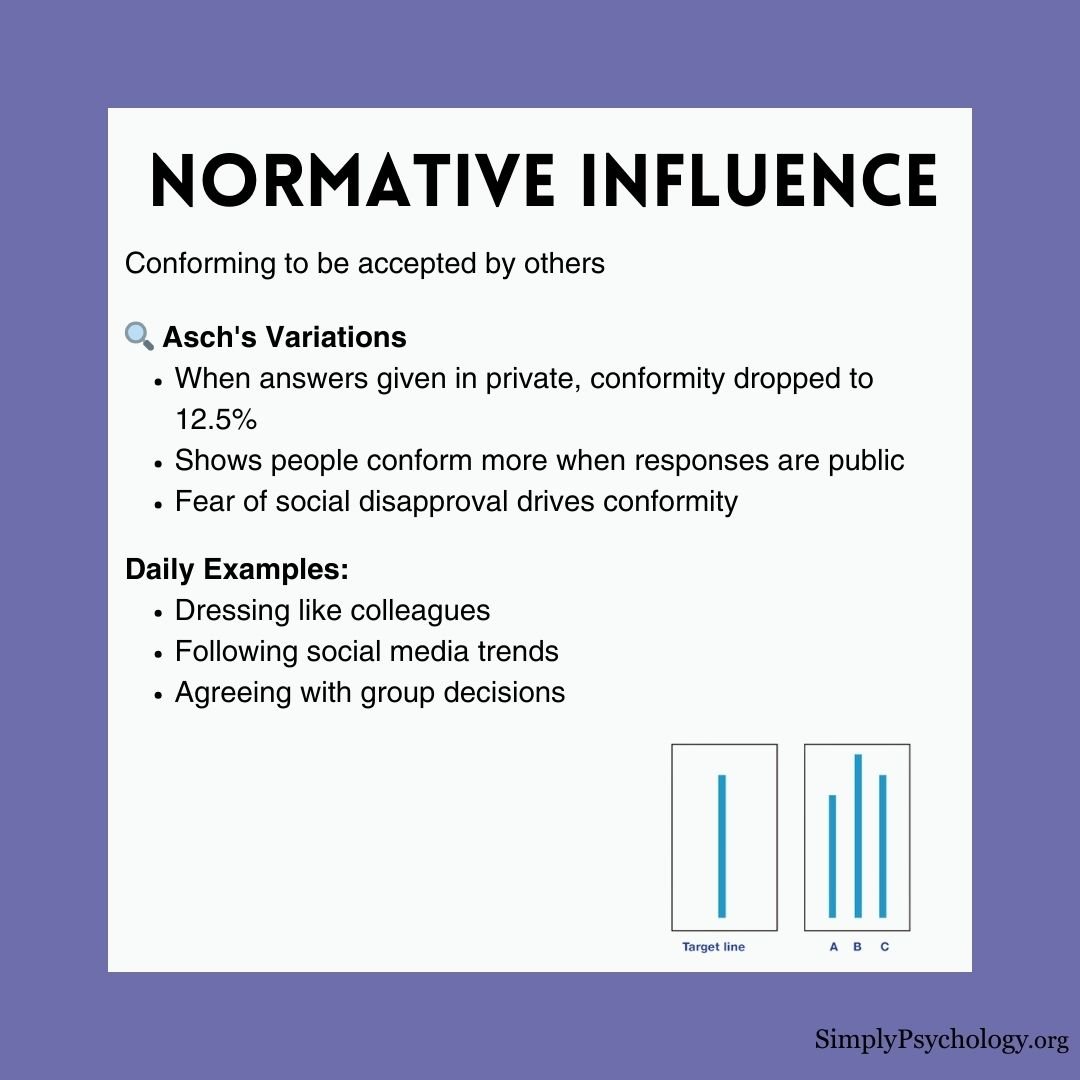There is no difference between AS and A-level for the Social Influence topic — the content is identical in both specifications.
Social influence is the process by which an individual’s attitudes, beliefs or behaviour are modified by the presence or action of others. Four areas of social influence are conformity, compliance and obedience, and minority influence.
Conformity (Majority Influence)
Conformity is defined as a type of social influence. It is yielding to group pressures or a change in a person’s behaviour or opinion as a result of a real or imagined pressure from a person or group of people. Real pressure involves consequences for conforming, while imagined pressure involves no consequences for not conformingIt is also known as majority influence.
Types of Conformity
According to Kelman (1958), there are three types of conformity: internalisation, identification, and compliance. These are also sometimes seen as levels of conformity. Note – you no longer need to learn about identification for the 2027 exam.
Compliance AO1
This refers to instances where a person may agree in public with a group of people, but the person privately disagrees with the group’s viewpoint or behaviour.
The individual changes their views, but it is a temporary and superficial change.
The behaviour change is driven by the desire to gain approval or avoid disapproval (often due to normative pressure).
For example, a person may laugh at a joke because their group of friends find it funny but deep down the person does not find the joke funny.
Another example is drinking alcohol with friends even if you don’t want to, and not drinking outside of those social situations
Compliance is the weakest form of conformity and lasts only as long as group pressure is present.
For a study on compliance refer to Asch’s Line Study.
View this post on Instagram
Internalisation AO1
Publicly changing behaviour to fit in with the group while also agreeing with them privately.
An internal (private) and external (public) change of behaviour.
This is the deepest level of conformity were the beliefs of the group become part of the individual’s own belief system.
This type of conformity usually lasts even if the majority is no longer present and is most likely linked to Informational Social Influence.
An example of internalisation is if someone lived with a vegetarian at university and then decides to also become one too because they agree with their friend’s viewpoint / someone converting religions would also be a good example.
For a study on internalisation refer to Jenness (see below).
View this post on Instagram
Explanations for Conformity
There are two main explanations for conformity: Informational Social Influence and Normative Social Influence. These are also known as the two theories Deutsch & Gerard proposed to explain conformity
Normative Influence (AO1/AO3)

Normative social influence is where a person conforms they want to be liked and be part of a group.
It is driven by a person’s need to be accepted or have approval from a group.
Normative social influence is usually associated with compliance, where a person changes their public behaviour but not their private beliefs.
Normative social influence often happens when a person wants to avoid the embarrassing situation of disagreeing with the majority or through fear of rejection or being seen as an outcast
For example, a person may feel pressurised to smoke because the rest of their friends are. Normative Social influence tends to lead to compliance because the person smokes just for show but deep down they wish not to smoke. This means any change of behaviour is temporary.
For a study on normative influence refer to Asch.
Not everyone is equally affected by normative pressure. Some people have a high need for affiliation (nAffiliators) and are more likely to conform to be liked, whereas others who are less concerned with social approval may resist NSI.
Informational Influence (AO1/AO3)
Informational social influence is where a person conforms because they have a desire to be right, and look to others who they believe may have more information.
They look to others by copying them to find the correct answer, especially when a person is uncertain or unsure of a situation or lacks knowledge.
It usually leads to internalisation, resulting in a permanent change in view or behaviour.
It occurs in ambiguous, difficult, or novel situations where we lack the knowledge or expertise to make our own decisions.
For example, a person following a crowd in an emergency, assuming others know the way.
Another example is if someone was to go to a posh restaurant for the first time, they may be confronted with several forks and not know which one to use, so they might look to a near by person to see what fork to use first.
For a study on informational influence refer to Jenness (see below).
Jenness’ Bean Jar Experiment AO1
Jenness carried out a study into conformity – in his experiment participants were asked to estimate how many beans they thought were in a jar.
Each participant had to make an individual estimate, and then do the same as a group.
He found that when the task was carried out in a social group, the participants would report estimates of roughly the same value (even though they had previously reported quite different estimates as individuals).
The study was successful in showing majority influence, thus proving that individuals” behaviour and beliefs can be influenced by a group.
Additionally, this is likely to be an example of informational social influence as participants would be uncertain about the actual number of beans in the jar.
Variables Affecting Conformity
Asch’s Line Study AO1

Asch wanted to investigate whether people would conform to the majority in situations where an answer was obvious.
Procedure: In Asch’s study there were 5-7 participants per group. Each group was presented with a standard line and three comparison lines.
Participants had to say aloud which comparison line matched the standard line in length.
In each group there was only one real participant the remaining 6 were confederates. The confederates were told to give the incorrect answer on 12 out of 18 trails.
Results: Real participants conformed on 32% of the critical trials where confederates gave the wrong answers. Additionally, 75% of the sample conformed to the majority on at least one trial.
View this post on Instagram
Factors Affecting Conformity AO3
In further trials, Asch (1952, 1956) changed the procedure (i.e., independent variables) to investigate which situational factors influenced the level of conformity (dependent variable). His results and conclusions are given below:
1. Group Size
An individual is more likely to conform in a larger group.
Asch altered the number of confederates in his study to see how this effected conformity. The bigger the majority group (number of confederates), the more people conformed, but only up to a certain point.
With one confederate, conformity was 3%, with two, it increased to 13%, and with three or more, it was 32%.
Conformity rose by 30% when there were more than 3 confederates.
However, conformity does not seem to increase much after the group size is about 4 or 5, which is considered the optimal group size
Because conformity does not seem to increase in groups larger than four, this is considered the optimal group size.

Brown and Byrne (1997) suggest that people might suspect collusion if the majority rises beyond three or four.
According to Hogg & Vaughan (1995), the most robust finding is that conformity reaches its full extent with 3-5 person majority, with additional members having little effect.
2. Group Unanimity
A person is more likely to conform when all members of the group agree and give the same answer.
When one other person in the group gave a different answer from the others, and the group answer was not unanimous, conformity dropped.
Asch (1951) found that even the presence of just one confederate that goes against the majority choice can reduce conformity as much as 80%.
3. Difficulty of Task
An individual is more likely to conform when the task is difficult.
When the (comparison) lines (e.g., A, B, C) were made more similar in length it was harder to judge the correct answer and conformity increased.
When we are uncertain, it seems we look to others for confirmation. The more difficult the task, the greater the conformity.
This suggests that informational social influence is a major mechanism for conformity when the situation is ambiguous.
4. Answer in Private
When participants were allowed to answer in private (so the rest of the group does not know their response) conformity decreases.
This decreases conformity because there are fewer group pressures and normative influence is not as powerful, as there is no fear of rejection.
Obedience
Obedience is a type of social influence where a person follows an order from another person who is usually an authority figure.
Explanations for Obedience
Milgram’s Shock Study AO1
Milgram wanted to know why Germans were willing to kill Jews during the Holocaust. He thought that it might have been because German’s were just evil.
He thought that Americans were different and would not have followed such orders. To test this ‘German’s are different’ hypothesis he carried out this study (outlined below).

Procedure: Milgram wanted to see whether people would obey a legitimate authority figure when given instructions to harm another human being.
He conducted a lab experiment in which two participants were assigned either the role of a teacher (this was always given to the true participant) or learner (a confederate called Mr. Wallace).
The teacher and learner were put into separate rooms.
The teacher was then asked by the experimenter (who wore a lab coat) to administer electric shocks (which were actually harmless) to the learner each time he gave the wrong answer.
These shocks increased every time the learner gave a wrong answer, from 15 – 450 volts.

The experimenter (Mr Williams) wore a grey lab coat and his role was to give a series of orders / prods when the participant refused to administer a shock.
There were 4 prods and if one was not obeyed then the experimenter read out the next prod, and so on.
- Prod 1: please continue.
- Prod 2: the experiment requires you to continue.
- Prod 3: It is absolutely essential that you continue.
- Prod 4: you have no other choice but to continue.
Results: The results were that all participants went to 300 volts and 65% were willing to go all the way to 450 volts. Milgram did more than one experiment – he carried out 18 variations of his study.
All he did was alter the situation (IV) to see how this affected obedience (DV).
For example, when the experimenter instructed and prompted the teacher by telephone from another room, obedience fell to 20.5%.
The Agentic State
This is when a person believes that someone else will take responsibility for their actions.
Agency theory suggests people are more likely to obey when in the agentic state because they don’t believe they will suffer the consequences of those actions.
They believe they are acting on behalf of an agent.
The shift from an autonomous state (where a person takes responsibility for their own actions) to the agentic state is called an Agentic Shift.
Agency theory is supported by Milgram’s evidence; for example, when participants were reminded they had responsibility, few obeyed, but many who were refusing continued if the experimenter said he would take responsibility.
Another example of the agenetic state involved a variation of Milgram’s study whereby participants could instruct an assistant (confederate) to press the switches.
In this condition 92.5% shocked to the maximum 450 volts. This shows when there is less personal responsibility obedience increases.
Being in the agentic state makes a person ‘unthinkingly’ carry out orders and involves diffusion of responsibility.
Limitations AO3
-
- Cannot explain Nazi behaviour – Mandel described how the German Police Reserve shot civilians in a small Polish town even though they were not directly ordered to and were told they could be assigned to other duties – Challenges agentic state as they were not powerless to obey.
-
- May be better explained by ‘plain cruelty’ – Zimbardo’s participants may have used the situation to express their sadistic tendencies, guards inflicted rapidly escalating cruelty to prisoners even though there was no authority figure telling them to – Obedience may be caused by certain aspects of human nature.
Situational Variables Affecting Obedience as Investigated by Milgram
The Milgram experiment was carried out many times whereby Milgram varied the basic procedure (changed the IV).
By doing this Milgram could identify which situational factors affected obedience (the DV).
Obedience was measured by how many participants shocked to the maximum 450 volts (65% in the original study).
1. Authority Figure Wearing a Uniform
Milgram’s experimenter (Mr. Williams) wore a grey laboratory coat (a symbol of scientific expertise) which gave him a high status.
However, when the experimenter dressed in everyday clothes, obedience was very low.
Uniform acts as a visible sign of authority, increasing legitimacy and status.
2. Status of Location
Milgram’s obedience experiment was conducted at Yale, a prestigious university in America.
The high status of the university gave the study credibility and respect in the eyes of the participants, thus making them more likely to obey.
When Milgram moved his experiment to a set of run down offices rather than the impressive Yale University obedience dropped to 47.5%. This suggests that status of location effects obedience.
3. Proximity of Authority Figure (and Learner)
This refers to the physical closeness between the teacher and the learner, and the teacher and the experimenter.
People are more likely be obey an authority figure who is in close proximity (i.e. nearby).
In Milgram’s study the experimenter was in the same room as the participant (i.e. teacher).
If the authority figure is distant it is easier to resistant their orders.
When the experimenter instructed and prompted the teacher by telephone from another room, obedience fell to 20.5%.
Decreased proximity to the authority figure meant participants returned to a more autonomous state.
Many participants cheated and missed out shocks or gave less voltage than ordered to by the experimenter.
Dispositional Explanation: Authoritarian Personality
Adorno felt that personality (i.e. dispositional) factors rather than situational (i.e. environmental) factors could explain obedience.
He proposed that there was such a thing as an authoritarian personality, i.e. a person who favours an authoritarian social system and, admires obedience to authority figures.
One of the various characteristics of the authoritarian personality is that the individual is hostile to those who are of inferior status, but obedient of people with high status.
They have a strict adherence to conventional norms, an intolerance of ambiguity, and a black-and-white worldview (no grey areas)
In essence, they believe in the need for strong leadership and hierarchy – everyone should know their place, with no challenge to those above and no mercy to those below.
In essence, they believe in the need for strong leadership and hierarchy – everyone should know their place, with no challenge to those above and no mercy to those below.
He investigated 2000 middle class, white Americans and their unconscious attitudes towards other racial groups using the F-scale to measure authoritarian personality.
In their 1950 study of over 2000 middle-class white Americans, Adorno et al. found those with higher F-scale scores indeed showed the traits of authoritarian personality:
They were more prejudiced, viewed society as needing strong leaders to eradicate evil, and were inflexible in their outlook.
Limitations AO3
- Adorno found many significant correlations (e.g. Authoritarianism correlated with prejudice against minority groups) but we cannot say that one variable causes another – Adorno cannot claim that a harsh parenting style caused a development of an Authoritarian personality, we must consider other explanations like legitimacy of authority.
- Millions of individuals in Germany displayed obedient behaviour but didn’t have the same personality, it is unlikely that the majority of Germany’s population possessed an authoritarian personality – An alternative explanation like social identity theory (people identify with groups they are apart with and discriminate against ones they are not) may be more realistic.
- May be better explanations – Prejudice and submissiveness could just as easily be caused by a poor standard of education as a child – Theory lacks internal validity as it assumes obedience is caused by dispositional explanations when it may be situational variables.
- Adorno used a biased sample – Only used 2000 middle class white Americans who are more likely to have an Authoritarian personality due to demographics and the time of the study – Research lacks population validity and historical validity, so conclusions cannot be generalised to people outside the sample.
Resistance to Social Influence
Resisting social influence means not yielding to pressures to conform or obey. Two key factors that help people resist are the presence of social support and an individual’s locus of control.
Other possible explanations for resistance to social influence mentioned include reactance (the ‘boomerang effect’), status, morality, ionic deviance, being in an autonomous state, previous experience, high level of moral reasoning, and factors like lack of uniform, increased distance, reduced group size, or lack of task ambiguity. Prior commitment can also be a reason for resistance.
Social Support
The presence of people helps others resist pressure to conform or obey.
Having an ally or seeing someone else resist can strengthen an individual’s ability to withstand group or authority pressure
1. Resisting Conformity:
Seeing others non-conform gives confidence to do so. Having an ally breaks the unanimity of the group.
As shown in Asch’s conformity experiments, if one of the confederates disagreed with the majority (even if they gave a different wrong answer or the correct answer), the participant’s conformity dropped sharply – to about 1/4 of its previous level.
Just one dissenter broke the unanimity and provided a model of independent behaviour, making it easier for the participant to follow their own conscience.
The ally’s dissent confirms the participant’s own perceptions (“I’m not the only one who sees it differently”) and reduces the normative pressure (since the majority is no longer unanimous in disapproval)
Essentially, the presence of a non-conforming person frees others to not conform. This effect isn’t long-lasting if the ally starts conforming again – but at least temporarily, it boosts confidence.
2. Resisting Obedience:
Disobedient models facilitate disobedience.
Seeing others disobey can demonstrate the possibility of defying the experimenter and can sharpen the participant’s sense of personal responsibility.
In Milgram’s obedience variations, when participants were in a team of three teachers (two of whom were confederates who refused to continue at certain points), the obedience of the real participant plummeted.
Only 10% of participants continued to 450V when they saw their peers disobey the experimenter
The disobedient confederates acted as a model for rebellion, showing the participant that one can stand up to authority. This peer support made it far easier for participants to defy the experimenter’s orders.
In another study, Gamson et al. (1982) had participants in groups discuss a morally questionable situation (to produce evidence to help an oil company smear a manager). They found 88% of groups rebelled against the orders – a much higher resistance rate than Milgram’s individuals
The key difference was the participants were in groups, so they could reinforce each other’s resistance.
These findings illustrate that social support undermines the legitimacy of authority or majority pressure, giving individuals courage to resist.
Why it works: Social support works through both normatie social influence (NSI) and informational social influence (ISI) pathways.
An ally reduces the fear of isolation (NSI is reduced because you’re not the only deviant) and can also provide an alternative viewpoint that might be correct (ISI – they might provide information that challenges the authority/majority).
For example, in Asch’s study, a dissenter providing the correct answer not only broke unanimity but also validated the participant’s own judgment, reducing conformity due to both normative and informational influence.
In essence, “strength in numbers” – even a small break in consensus can tilt the balance towards independent behaviour.
Locus of Control
Locus of control (LOC) is a measurement of an individual’s sense of control over their lives.
It measures the extent to which people feel events in their lives are under their own personal control (internal LOC) versus under the control of external powers like fate (external LOC)
There is a continuum, with most people lying in between.
Internal LOC:
People with a more internal locus of control conform and obey less.
They take more responsibility for their actions and see themselves as having more control.
An internal LOC enables greater personal efficacy and self-confidence.
They are more likely to make decisions based on their own moral code.
People with a high internal LOC are more likely to be leaders, not followers.
External LOC:
People with an external locus of control believe the majority of their life events are beyond their control.
They are more likely to act on behalf of another (as an agent) and shift responsibility.
They are particularly susceptible to obedience.
Externals may be more prone to learned helplessness and tend to follow others because they don’t think they can control what happens anyway.
In social influence, externals are more likely to conform or obey, attributing outcomes to external pressure rather than their own agency.
Research Support (AO3)
Limitations (AO3)
Minority Influence
Minority influence occurs when a minority group influences the majority. Minority influence is the main cause of social change. It often leads to internalisation – the majority actually change their private views after being influenced, though this tends to happen gradually. Key processes that make minority influence effective are consistency, commitment, and flexibility.
Other processes involved in minority influence and social change include drawing attention to their beliefs, deeper processing of the issue in the majority group, the augmentation principle, the snowball effect, and social cryptomnesia.
1. Consistency
Consistency is a behaviour that enables a minority to influence a majority
Minorities need to be consistent in their opinions and behaviour.
This includes being consistent over time (diachronic consistency) and consistent between members (synchronic consistency).
Consistency forces the majority to think deeply about the issue because the repetition and united front imply a strong, valid point.
A consistent minority causes the majority to at least reassess the issue: “They keep saying the same thing… they might have a point.”
Moscovici theorised that consistency makes the majority members start to doubt themselves and consider the minority view more seriously.
However, too much consistency without flexibility can seem dogmatic (see below).
In practice, consistency should be combined with rational argumentation – simply repeating an assertion isn’t enough, but holding firm to a clear stance is key.
Procedure:
Moscovici aimed to determine the importance of consistency to the influence of the minority.
Moscovici conducted an experiment in which female participants were shown 36 blue slides of different intensity and asked to report the colours. There were two confederates (the minority) and four participants (the majority).
In the first part of the experiment the two confederates answered green for each of the 36 slides. They were totally consistent in their responses. In the second part of the experiment they answered green 24 times and blue 12 times. In this case they were inconsistent in their answers. A control group was also used consisting of participants only – no confederates.
Findings: When the confederates were consistent in their answers about 8% of participants said the slides were green. When the confederates answered inconsistently about 1% of participants Said the slides were green.
2. Commitment
Minorities need to demonstrate commitment. They show resistance to social pressures and abuses against their viewpoint.
A minority that shows dedication to their cause (especially through personal sacrifice or suffering) is more likely to be influential.
This is often explained via the augmentation principle – if the minority undergoes extreme activities or risks to further their cause, it amplifies their impact. It shows they are not acting out of self-interest; they truly believe in their view.
For example, if environmental activists chain themselves to trees or go on hunger strikes, their commitment is evident.
Observers are more likely to pay attention and consider “why would they do that unless they really have a strong point?”
High commitment can also create a sense of guilt or question in the majority – “perhaps our complacency is wrong if these people are willing to suffer for this.”
Therefore, commitment can convert more onlookers by demonstrating certainty and courage, making the minority message more compelling.
3. Flexibility
Minorities should be moderate, co-operative, and reasonable.
While consistency is vital, being inflexible and rigid can backfire.
If the minority refuses to compromise or consider alternate ideas, the majority may dismiss them as extremists or unrealistic.
Psychologist Nemeth (1986) argued that effective minorities strike a balance: they remain consistent in principle but demonstrate flexibility by adapting their arguments, listening to others, and sometimes making small concessions.
A flexible minority can engage the majority in dialogue.
For instance, in a jury setting, if one juror (minority) consistently argues a defendant is not guilty but also acknowledges valid points from others and is open to discussion, the rest are more likely to consider his view seriously than if he stubbornly repeats himself.
AO3
In short, consistency without being inflexible is key – consistency shows commitment to the core issue, while flexibility shows an open mind.
This possibility was investigated by Nemeth.
Their experiment was based on a mock jury in which groups of three participants and one confederate had to decide on the amount of compensation to be given to the victim of a ski-lift accident.
When the consistent minority (the confederate) argued for a very low amount and refused to change his position, he had no effect on the majority.
However, when he compromised and moved some way towards the majority position, the majority also compromised and changed their view.
This experiment questions the importance of consistency. The minority position changed, it was not consistent, and it was this change that apparently resulted in minority influence.
A-Level Psychology Revision Notes







